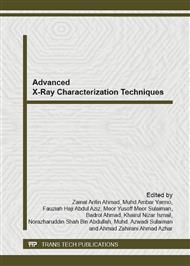p.378
p.384
p.389
p.395
p.400
p.405
p.412
p.418
p.424
Synthesis and Characterization of MWCNT/Dolomite Hybrid Compound as Potential Composite Fillers
Abstract:
Multiwalled carbon nanotubes/dolomite (MWCNT/dolomite) hybrid compound was synthesized using the Chemical Vapour Deposition (CVD) technique. The catalyst was prepared via the co-precipitation method. The process involves the drying of the precipitate followed by calcination at 900°C.Upon completion of calcinations process, the reduction process was carried under H2 at 400°C and growth in a CH4/N2 gas mixture at 800°C for 30 minutes The reduction process was carried out under H2 and growth in a CH4/N2 gas mixture at 800°C for 30 minutes. The morphological assessment using Field Emission Scanning Electron Microscope (FESEM) showed that the CNT was successfully grown on dolomite particle. High Resolution Transmission Electron Microscope (HRTEM) micrograph further confirmed the presence of MWCNT with varied length and geometry on dolomite surfaces, supported the formation of MWCNT on the dolomites particle.
Info:
Periodical:
Pages:
400-404
Citation:
Online since:
December 2012
Keywords:
Price:
Сopyright:
© 2013 Trans Tech Publications Ltd. All Rights Reserved
Share:
Citation:


